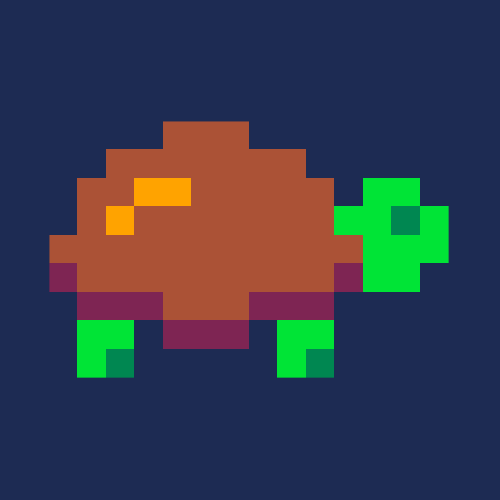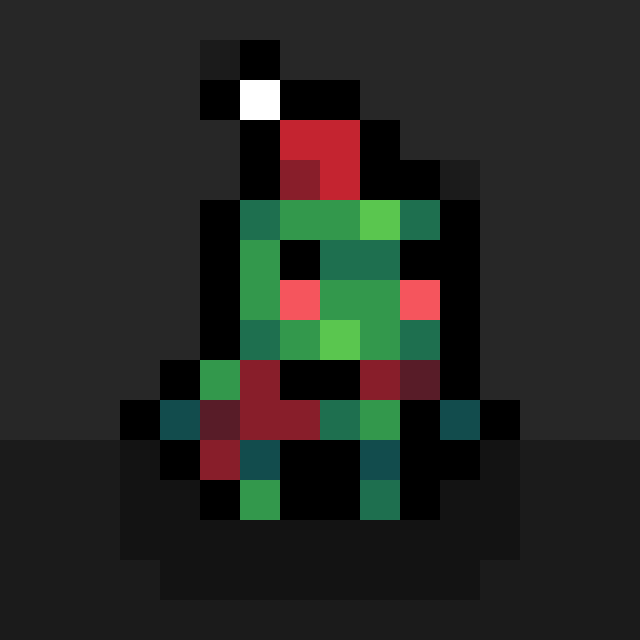In short, it's quite similar to Pico, but enhanced (for example, you can set custom palettes or even "chase the beam", similarly to what you could do on machines like Atari ST or Amiga, which, if done properly can mean breaking out of 16 colors limit. Also sound capabilities seems to be enhanced to what Pico offers, since you can edit waveforms. It has also panoramic screen and slightly higher resolution, both vertically and horizontally (240x136).
It too uses Lua (and Moonscript if you prefer it) and api is quite similar, though not an exact match.
I hope zep doesn't mind me posting there.
Link: https://tic.computer
Thanks to dddaaannn for letting me know about this stuff.
And as additional discussion seed, have any 3D wizards such as electric gryphon considered porting their stuff to Tic-80? It should be easier to since it has a native trifill function. Also with enhanced graphic capabilities it could look even better.

I looked at it. Honestly, just kind of seems like a knock off. I like Pico's limitations. TIC-80 has some of them, but not as strict. I say, if you're going to do retro, go all-in with Pico. If you just want retro-styled, why not just script in pure lua and use a more powerful framework or something. Just my thoughts. Could be I'm biased and a Pico fanboy too.

Think of difference between Pico-8 and TIC-80 like difference between C64 and Atari ST. One has limited palette of fixed 16 colors, the other, while it can still only display 16 colors at a time, unless you do tricks like chasing the beam, can display a bigger range of colors due to being able to remap palette to arbitrary rgb values.

TIC-80 is pretty interesting--and I think has made some distinctive choices that make it more than just a knock-off. Worth checking out.
As an experiment, I wrote a wrapper library that makes it easy to port existing PICO-8 projects to TIC-80. You can find it here: https://github.com/musurca/pico2tic

Looks interesting - a different hardware approach in my opinion and far away from a rip off. A bite more screen space and comes as a home computer instead of a console. I'd love to see more machines like that, as I just slowly progress with my Nano89 :)

Yeah, almost forgot about Nano. How the progress on it goes? Is it anywhere close to release even as an (pre)alpha?

I have a fully working virtual CPU implemented in Python, which I'm porting for performance reasons to a C extension. Further, the graphic converter, which renders the memory to the screen with the screen mode settings, is ported to C as well, so I will soon assemble the stuff together again to get back to the old prototype state. That was able to load a cartridge, run code from it and do almost all stuff except the bit transfer coprocessor. But things run on low priority at the moment, as Pico-8 is now able to handle multiple cartridges in the web export. The lack of that was a big motivation pusher for the project ;), so at the moment, the whole thing is mostly about couriosity.

I think the more the merrier with this fantasy console idea. The biggest challenge any new creator faces, I think, is creating a large enough community vs. Pico-8 to be a viable product. Otherwise each one made will simply be a curiosity. I'm vaguely considering creating one of my own, actually, however, it's probably going to be much harder to write code for than the Pico-8, which means it'll basically be dead in the water, lol. But I'll be able to make my own games for it anyway ;)

Yeah, completely agree. I've actually had two things that could be considered one in development, but it was before the Pico-8 and the term came to light (one was inspired by Notch's DCPU-16 and the other by Voxatron's cart system and those old LCD brick games which in most basic form had Tetris inj it but could have multiple ones such as tanks or racing game).
There's even a discord for fantasy consoles: https://discord.gg/6ywAG5w

Yeah, in the beginning, Nano89 will be an assembler oriented system anyway. There will be a system ROM with all major functions of Pico-8 LUA commands, which map on the block transfer unit, but a specific BASIC I plan for the system is far away. On the other hand, Nano89 already allows you to build cartridges of up to 1MB, which are mapped as a 4KB page into the upper memory segment of the 8 bit CPU. Developing for Nano89 will be a very different experience compared to Pico-8, although the visuals are pretty similar. Yet, simply developing the beast is fun enough, we'll see, what a product it will become.
By the way, if someone's interested to test the CPU standalone - some basic Python knowledge required - be my guest to do so, I can mail you the files as long as there's no public repository or download package for them :).

Codea for iOS is another Lua based virtual console to add to the mix. It's been around for years and it's actively supported by the developers.

TIC-80 is interesting, but as others have said, it loosens up too many restrictions. E.g. having a trifill command might be nice for some folks, but some of us get our thrills from writing that stuff ourselves. I do love that you can change the font, though. Wish PICO-8 did that.
IIRC it's available as source, so it's tempting to grab it and trim it down to PICO-8 but with the ability to fix some of the more aggravating stuff zep seems unwilling to do, e.g. a cei() function, or upgrading to a more current lua with built-in binary ops. Just some conveniences that I'd really like to have without having to spend cycles and tokens on Lua wrappers for no good reason.
Also, re: TIC-80, not sure about moonscript. That language is rather too terse, IMHO, to the point where it gets kind of opaque. Nice thing about Lua is that it's simple and exceedingly readable for novices. But that's a philosophical call, I guess, as are a few other issues I have with moonscript. At least it's merely an option and not forced.

No, Liko-12 is available as source. The only thing TIC-80 uses Github for are wiki and issue tracker AFAIK.
And yes, I think tri() thing was a bit of overkill as well, but otherwise it's quite similar to what coding experience was on Atari ST.

@SunSailor as you mentioned ansi-basic, perhaps you might want to fork some parts of sdlBasic in it?

I'm green with envy over its resolution. I don't mean the game res, I mean the editors that fill the width of the screen.
Outside of that, I like the box that Pico-8 keeps me in. Tic-80 seems like something good to move on to at a later time.
But if Pico8 had editors that filled a PocketChip screen then I would give little thought to Tic-80. Just imagine what could be done with the map editor.
Ahhhh yeah.... that's good stuff.


I've used TIC-80 quite a bit, but after the release of pico-8 0.1.11 it lost all its interesting features for me :/

Let me ask a few questions, guys.
Does Tic-80 have ?
- Splore
- Load # online files for examination and playing.
- Save @clip so it can be posted on the main board.
- 32-color choices (pick 16).
- Total clipboard access. Read+Write from clipboard.
- Load+Save up to 12288-bytes in permanent SRAM per external file.
- PCM audio, new but works just fine.
- Breadcrumbs. Track one cart calling another.
- Compilation to EXE/Mac/Java/Htm.
- Inline HELP + examples for every single command.
Also, @nintendon't, if you are still around, there is now a free version of Pico-8 out that lets you load and save and publish your work either offline or online.

TIC-80 seems not interesting to me, because it's in the strange position of being
less limited than PICO-8
and also less powerful than a standard game engine.

TIC-80 is much, much more popular in the demoscene community for various reasons. PICO-8 has really struggled to capture that audience. For most other things PICO-8 seems to have more influence. See the number of TIC-80 entries in this weekend's Lovebyte demo party for example. For sizecoding in general TIC-80 seems to have even overtaken DOS.

I've played around with TIC-80 and found it quite nice, but for some reason doesn't have as much appeal as PICO-8. I think PICO-8's harsh limitations and unique choices like the square screen give it a unique flavor, whereas TIC feels a bit more traditional a to me.
I do really appreciate that TIC-80 is open source. I can see myself using it for some projects where PICO-8 is not quite a fit. It sits somewhere between PICO-8 and more powerful game engines.

@dw18
- Yes just not named Splore
- Yes
- Yes
- Pretty sure
- Yes
- Not sure
- Not sure but it has audio
- Not sure
- Exe, Mac, Linux, HTML, android (yes mobile apps)
- I don't think so... Does Pico have this?
[Please log in to post a comment]























